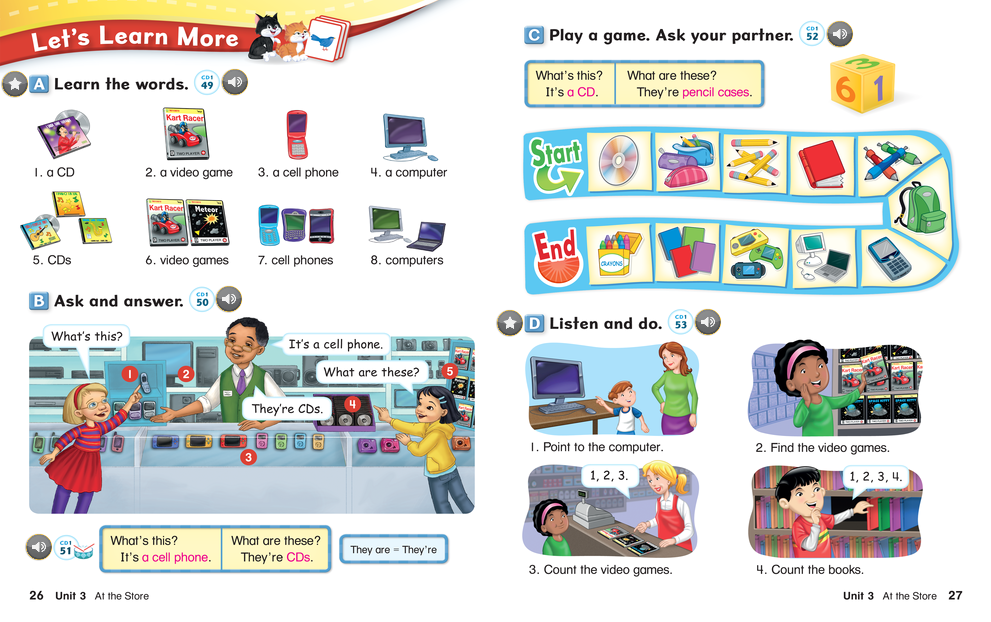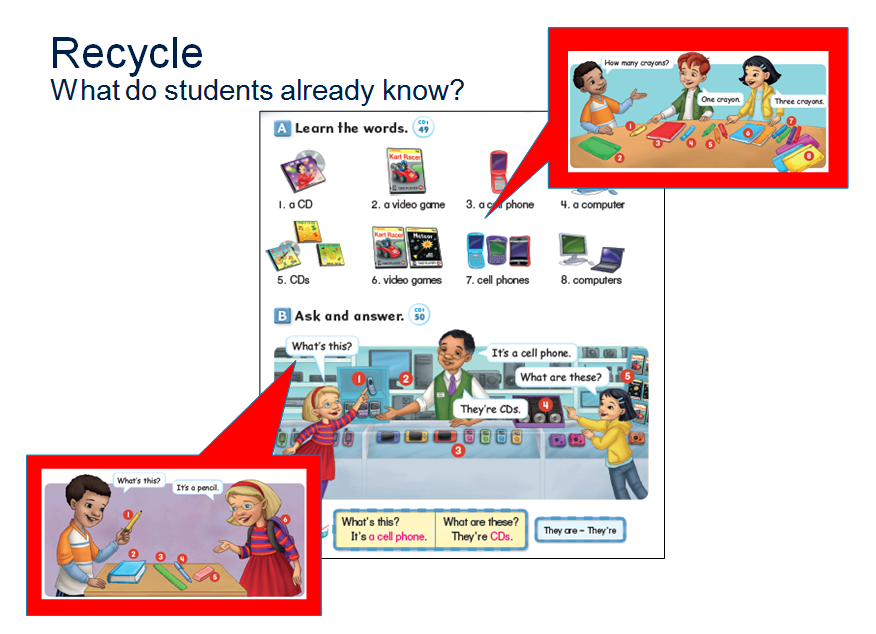 Barbara Hoskins Sakamoto, co-author of Let’s Go, outlines the benefits of only teaching young learners one new thing at a time by recycling, reinforcing, and building on new language.
Barbara Hoskins Sakamoto, co-author of Let’s Go, outlines the benefits of only teaching young learners one new thing at a time by recycling, reinforcing, and building on new language.
How can you get your students to learn more English? Teach less! It sounds counter-intuitive, but it’s true.
Teachers are often pressured to teach more – more vocabulary, more grammar, more content – to satisfy parents and administrators. Moving through a coursebook quickly becomes the measure of success. However, the classes in which I see students making the greatest progress are those in which teachers introduce relatively little new language and actively recycle previously learned language, spending the majority of class time reusing both new and familiar language in new contexts.
The measure of a successful lesson isn’t how much you teach; it’s how much students can do with the language they’ve learned.
There are certainly times when you might choose to throw students into the deep end of the language pool – when asking them to work at understanding the gist of a listening or reading task, for example. But, it should be a choice that works toward your lesson goals, not the standard approach. If you need to spend most of your class with books open, explaining the language on the page, then students are unlikely to remember much for the next class. You end up teaching the same things over, and over, and over again without much feeling of progress.
In contrast, when we recycle language in class, we’re teaching students how to use the language they already know to figure out language that they don’t. It’s one of the most important abilities that skilled language users employ.
There’s no way we will ever be able to teach our students all the English they’ll ever need to know, so instead let’s teach them how to be confident in their ability to figure things out for themselves. One of the easiest ways to model this skill is to introduce new language in the context of familiar. Another way of looking at this is to make sure you maximize the value of any language your students spend the time learning. Here’s one simple example of how using familiar language to introduce new language can help students learn more effectively.

If you teach without recycling familiar language, this looks like a dense lesson – eight new vocabulary words and two question and answer patterns. However, actively recycling previously learned language can make the lesson more manageable. For example, students have already learned the concept of plurals, and how to add an –s to the end of words to indicate more than one item. They may need to be reminded, but they don’t need to learn it again. That reduces the vocabulary load to four new words (and their plurals). What’s this? It’s a (CD) is also a very familiar pattern. It’s the first question students learned to ask and answer in the first book of the series to which this page belongs (Let’s Begin). It was recycled in a lesson two units prior to this lesson.

By recycling the familiar pattern with the singular vocabulary words, it’s a small step for students to understand that the new pattern, What are these?, is the same question but for asking about more than one of something. By reducing the amount of new language to be taught, students now have more time to practice the language they’ve learned. They can use the questions and answers with vocabulary from earlier lessons, or apply their plural-making skills to topics that interest them, or personalize the language and build new skills by using the language to write about things in their own lives (e.g., This is my bedroom. These are my CDs. This is my cell phone. etc.) and then to read what classmates have written. Language becomes a tool for communicating about things students want to talk about, and because language is constantly recycled, students are unlikely to forget it.
Active recycling plays a big part in Let’s Go, so the Teacher’s Book lists what language is being recycled in each lesson, and the ‘Let’s Remember’ lesson at the start of each level highlights familiar language from the previous level that will be built upon in the new one. You can do the same sort of recycling, with the same benefits, with any coursebook or even with no coursebook at all. You simply need to keep track of the language being taught so that you know what you can recycle to help students learn new language or build new skills.
A simple guideline is to teach one new thing (new pattern or new vocabulary, but not both) in each lesson, or for longer lessons or older students, in each section of a lesson. Reducing the amount of time spent on introducing new language creates more time for students to use language:
- to use it in games and activities that provide the repetition necessary for memory
- to add it to their language repertoire in order to talk about new things
- to learn to read what they can say and understand
- to use language they can read to write about their own unique lives and experiences
- and to use language to connect with other students in order to share their own and learn about others’ lives and experiences.
If you are interested to see how active recycling works in Let’s Go, you can download a variety of sample lessons from the Oxford Teachers’ Club Let’s Go teaching resources page.


What a wonderful piece. It’s so nice to get affirmation about how we should be teaching the little ones. Too often, even when the results are obvious to all with eyes, there’s this desperate need to do more, more, and more; way beyond what the students can retain.
Thank you for the kind remarks, Mark. I find often that teachers need reassurance to do what they know is best for their students, particularly in the face of pressure from parents and supervisors to push more. That, and some evidence to support their argument that teaching less could actually help students learn more 🙂
Reblogged this on amengental.
Thank you for sharing, and for linking back to the original 🙂
?
Thanks Barb. So much in life is less is more. I second Mark Armstrong’s comment.
Very true, Mark! And I know that this approach is already an essential part of your own teaching approach. The success your students find speaks to the value of focusing on learning more rather than teaching more. Keep up the excellent work!
[…] Barbara Hoskins Sakamoto, co-author of Let’s Go, outlines the benefits of only teaching young learners one new thing at a time by recycling, reinforcing, and building on new language. How can you g… […]
[…] Barbara Hoskins Sakamoto, co-author of Let’s Go, outlines the benefits of only teaching young learners one new thing at a time by recycling, reinforcing, and building on new language. How can you get your students to learn more English? […]
[…] Sound familiar? Read more of Barbara’s wonderful piece here. […]
Reblogged this on hungarywolf.
Thank you for sharing this, and for linking back to the original 🙂
It’s true, too much at one time is not good for any students, especially younger ones.
In my ‘language classroom’ I always have Benjamin Franklin’s words on my mind:
‘Tell me and I forget, teach me and I remember. Involve me and I learn’.
Involve me….so that I can revise what I’ve learnt…
You can’t go wrong with Ben Franklin as a guide 🙂
Students definitely learn best if we can involve multiple senses in our teaching and their learning, as do adults. Thanks for your comments, Magdalena!
[…] Teach less to help young students learn more […]